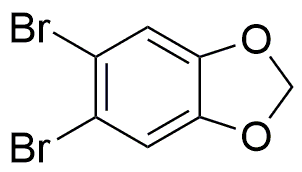5,6-Dibromo-1,3-benzodioxole is widely utilized in research focused on:
- Pharmaceutical Development: This compound serves as an important intermediate in the synthesis of various pharmaceuticals, particularly those targeting neurological disorders.
- Analytical Chemistry: It is used as a reagent in analytical methods to detect and quantify certain organic compounds, enhancing accuracy in chemical analysis.
- Material Science: The compound is explored for its potential in developing advanced materials, including polymers with unique properties for electronics and coatings.
- Agricultural Chemistry: It finds applications in the formulation of agrochemicals, contributing to the development of effective pesticides and herbicides.
- Environmental Monitoring: Researchers utilize it in studies assessing environmental pollutants, helping to track and mitigate chemical contamination in ecosystems.
Información general
Propiedades
Seguridad y normativas
Aplicaciones
5,6-Dibromo-1,3-benzodioxole is widely utilized in research focused on:
- Pharmaceutical Development: This compound serves as an important intermediate in the synthesis of various pharmaceuticals, particularly those targeting neurological disorders.
- Analytical Chemistry: It is used as a reagent in analytical methods to detect and quantify certain organic compounds, enhancing accuracy in chemical analysis.
- Material Science: The compound is explored for its potential in developing advanced materials, including polymers with unique properties for electronics and coatings.
- Agricultural Chemistry: It finds applications in the formulation of agrochemicals, contributing to the development of effective pesticides and herbicides.
- Environmental Monitoring: Researchers utilize it in studies assessing environmental pollutants, helping to track and mitigate chemical contamination in ecosystems.
Documentos
Hojas de datos de seguridad (HDS)
La SDS proporciona información de seguridad completa sobre la manipulación, el almacenamiento y la eliminación del producto.
Especificación del producto (PS)
La PS proporciona un desglose completo de las propiedades del producto, incluida la composición química, el estado físico, la pureza y los requisitos de almacenamiento. También detalla los rangos de calidad aceptables y las aplicaciones previstas del producto.
Certificados de análisis (COA)
Busque certificados de análisis (COA) ingresando el número de lote del producto. Los números de lote y de partida se pueden encontrar en la etiqueta de un producto después de las palabras "Lote" o "Lote".
Número de catálogo
Número de lote/lote
Certificados de origen (COO)
Este certificado de origen confirma el país en el que se fabricó el producto y también detalla los materiales y componentes utilizados en él y si se deriva de fuentes naturales, sintéticas u otras fuentes específicas. Este certificado puede ser necesario para cumplir con las normativas aduaneras, comerciales y regulatorias.
Número de catálogo
Número de lote/lote
Hojas de datos de seguridad (HDS)
La SDS proporciona información de seguridad completa sobre la manipulación, el almacenamiento y la eliminación del producto.
DownloadEspecificación del producto (PS)
La PS proporciona un desglose completo de las propiedades del producto, incluida la composición química, el estado físico, la pureza y los requisitos de almacenamiento. También detalla los rangos de calidad aceptables y las aplicaciones previstas del producto.
DownloadCertificados de análisis (COA)
Busque certificados de análisis (COA) ingresando el número de lote del producto. Los números de lote y de partida se pueden encontrar en la etiqueta de un producto después de las palabras "Lote" o "Lote".
Número de catálogo
Número de lote/lote
Certificados de origen (COO)
Este certificado de origen confirma el país en el que se fabricó el producto y también detalla los materiales y componentes utilizados en él y si se deriva de fuentes naturales, sintéticas u otras fuentes específicas. Este certificado puede ser necesario para cumplir con las normativas aduaneras, comerciales y regulatorias.


